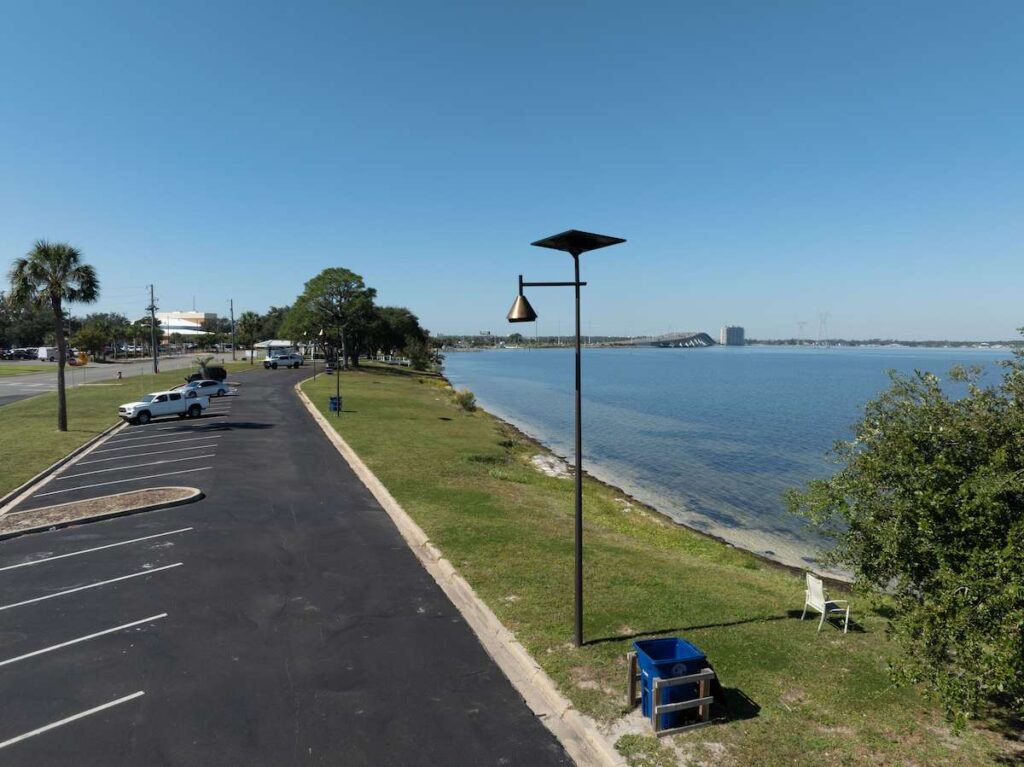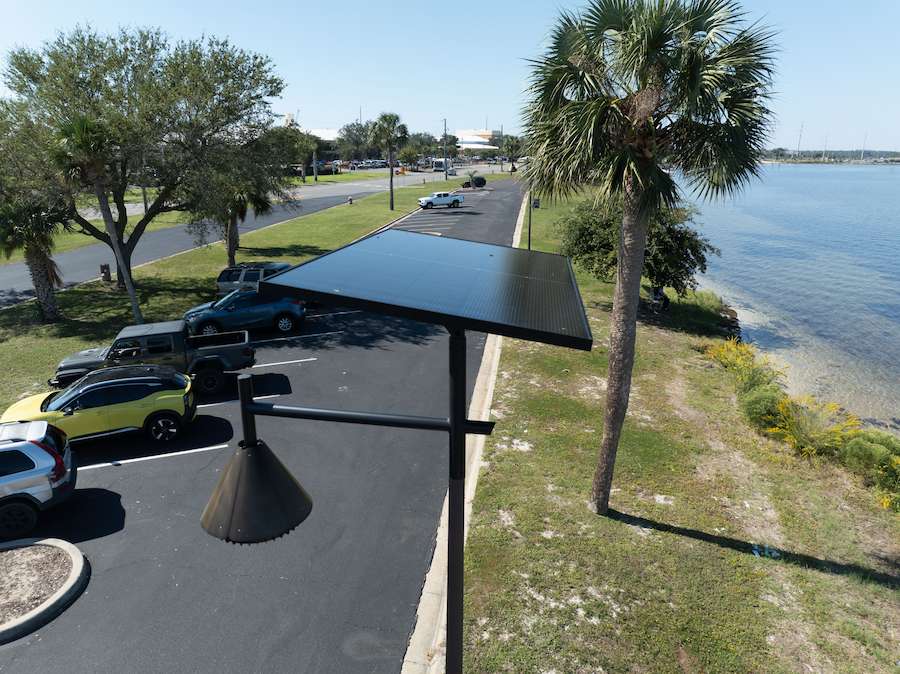Storm-Ready Lighting Solutions for Coastal South Carolina Communities
When hurricanes strike South Carolina’s coast, they don’t just bring wind and rain; they bring darkness. Prolonged power outages can leave entire neighborhoods, evacuation routes, and public spaces unsafe for days. Across the Lowcountry, from Charleston to Beaufort to Myrtle Beach, counties are confronting the hard truth: traditional grid-tied streetlights fail when the grid does.
Fonroche Lighting America’s off-grid, solar-powered Smart Lights deliver the resilience the coast demands. Designed for hurricane zones and flood-prone terrain, these systems operate 365 nights a year, with no trenching, no cabling, and no reliance on utilities. Even when the grid goes down, Fonroche lights stay on, keeping communities safe, visible, and connected. As storm seasons intensify and recovery costs rise, South Carolina municipalities are turning to storm-ready solar lighting solutions that not only enhance coastal resilience but are also transforming downtown areas into safer, more vibrant spaces.
South Carolina’s Rural Road Safety Challenge
South Carolina’s rural counties, including Marlboro, Chesterfield, Dillon, Marion, Barnwell, and Sumter, rely on thousands of miles of unlit roads that become dangerous after dark. With limited visibility, drivers face higher risks of collisions involving wildlife, sharp curves, and narrow shoulders. As a result, nighttime crash rates on rural highways remain significantly higher than on well-lit roads.
Emergency responders also face delays navigating pitch-black routes, losing valuable minutes during critical calls. And because much of rural South Carolina lacks grid access or electrical infrastructure, extending traditional lighting isn’t feasible or affordable. This growing safety gap highlights the urgent need for smarter, cost-effective lighting solutions that can operate independently of the grid.
The Real Cost of Darkness on Rural Highways
Lighting rural roads with traditional grid-tied systems is far more costly and complex than most South Carolina counties can sustain. Trenching miles of roadway requires heavy equipment, specialized labour, and extensive permitting, making even small lighting projects budget-breaking. Once installed, grid lighting becomes a recurring expense, vulnerable to copper theft, storm-related damage, and ongoing electrical failures that demand constant attention from already limited public works crews.
Beyond financial strain, the human cost of unlit roads is even greater. Poor visibility increases nighttime crashes, raises insurance claims, and exposes counties to higher liability risks. And because many rural corridors lack existing utility infrastructure, expanding the grid is slow, expensive, and often blocked by terrain challenges. These barriers make grid-tied lighting unrealistic for many rural communities and highlight why off-grid solar alternatives are becoming the safer, smarter path forward.

Why Solar Street Lighting Is the Ideal Solution for Rural Corridors
Solar street lighting solves the biggest challenges facing South Carolina’s rural roadways. With no need for trenching, wiring, or grid access, these systems install quickly and operate reliably in areas where traditional infrastructure is costly or impossible to extend. Fonroche’s Power 365™ technology ensures illumination every night of the year, even during storms or extended cloudy periods, making it a critical safety asset for hurricane-prone counties. Built to meet SCDOT and AASHTO standards, solar lighting improves visibility, reduces nighttime crashes, and provides long-term reliability with virtually no maintenance.
Key Advantages:
• Zero trenching or electrical work – major time and cost savings
• Operates through outages and extreme weather
• 1-hour installation per pole
• Designed for rural setbacks and wide shoulders
• Minimal maintenance and no energy bills
Stakeholders Transforming Safety Across Rural South Carolina
Solar-powered rural road lighting delivers meaningful value to every group responsible for transportation, safety, and community development. By removing the cost and limitations of grid expansion, counties and towns can finally illuminate their highest-risk corridors while improving emergency response, protecting school transportation routes, and strengthening public safety across long stretches of rural roadway. These systems are easy to specify, fast to install, and built to support South Carolina’s safety goals — making them a practical solution for agencies, planners, and community leaders statewide.
Who Benefits:
• County Transportation Departments: Improve roadway safety without expensive electrical infrastructure.
• SCDOT Regional Offices: Deploy lighting quickly along high-priority rural corridors.
• Emergency Services: Gain clearer nighttime visibility for faster, safer response.
• Rural School Districts: Protect bus routes and early-morning pickup areas.
• Public Works Teams: Reduce maintenance demands with autonomous, off-grid systems.
• Engineering & Planning Firms: Simplify project design with compliant, easy-to-spec lighting.
• Small Town Governments: Access to affordable upgrades without large capital projects or utility coordination.

Solar Lighting for Safer, Smarter Communities
Will solar streetlights provide enough brightness for rural roads?
Yes. Fonroche solar streetlights use high-efficiency LEDs delivering over 190 lumens per watt, offering powerful, uniform lighting comparable to grid-tied systems. Custom photometric studies ensure each project meets AASHTO and IES standards for rural roadway visibility.
How durable are solar lights in harsh rural conditions?
Fonroche systems are built to last. With operating ranges from -40°F to +158°F, IP67- and IK09-rated components, and wind-resistant poles engineered to EN40 standards, they withstand extreme heat, cold, dust, rain, and high winds with no performance loss.
Do solar streetlights keep working during power outages or storms?
Yes. Since they are fully off-grid, Fonroche solar lights continue to operate during utility failures caused by hurricanes, floods, or wildfires. Their Power 365 battery system guarantees 365 nights of lighting per year, even during prolonged cloudy periods.
Are these systems compliant with federal and state transportation standards?
Absolutely, Fonroche solutions are compliant with DOT, AASHTO, IES, and local municipality standards. Each system is tailored based on a decade of weather data, solar resource mapping, and lighting simulations to meet required safety and performance benchmarks.
What site preparation or infrastructure is required for installation?
Minimal. Fonroche solar lights require no trenching, conduit, grid hookups, or utility permitting. A basic concrete footing is sufficient, and most lights can be installed in under an hour, even in remote or off-grid areas.
How long do these systems last?
Fonroche systems are built for long-term reliability, with major components lasting 10 to 30 years depending on usage and conditions.
How much can we save on solar instead of grid lighting?
Solar lighting eliminates utility bills and reduces installation costs by up to 75%. Rural towns often recover their investment in 3–5 years, even faster in areas with high trenching costs, unreliable grid access, or frequent power outages.
Light South Carolina’s Rural Roads, Safely, Affordably, and Without the Grid
From county highways to remote intersections, Fonroche delivers reliable lighting that saves lives and budgets.
Our solar-powered SmartLights operate independently of the electrical grid, making them ideal for rural corridors where trenching, cabling, and outages are costly or impossible. With fast installation, zero utility bills, and 365 nights of guaranteed lighting, Fonroche is your trusted partner for rural infrastructure.

